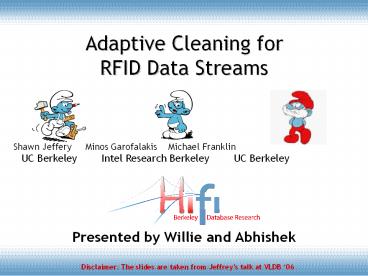Adaptive Cleaning for RFID Data Streams - PowerPoint PPT Presentation
Title:
Adaptive Cleaning for RFID Data Streams
Description:
... The s are taken from Jeffrey's talk at VLDB 06. 11/10/09 ... RFID data is dirty. A simple experiment: 2 RFID-enabled shelves. 10 static tags. 5 mobile tags ... – PowerPoint PPT presentation
Number of Views:32
Avg rating:3.0/5.0
Title: Adaptive Cleaning for RFID Data Streams
1
Adaptive Cleaning for RFID Data Streams
- Presented by Willie and Abhishek
Disclaimer The slides are taken from Jeffreys
talk at VLDB 06
2
RFID Radio Frequency IDentification
3
RFID data is dirty
- A simple experiment
- 2 RFID-enabled shelves
- 10 static tags
- 5 mobile tags
4
RFID Data Cleaning
- RFID data has many dropped readings
- Typically, use a smoothing filter to interpolate
SELECT distinct tag_id FROM RFID_stream RANGE 5
sec GROUP BY tag_id
But, how to set the size of the window?
Smoothed output
Raw readings
Time
5
Window Size for RFID Smoothing
Fido moving
Fido resting
Reality
Raw readings
Small window
Large window
? Need to balance completeness vs. capturing tag
movement
6
Truly Declarative Smoothing
- Problem window size non-declarative
- Application wants a clean stream of data
- Window size is how to get it
- Solution adapt the window size in response to
data
7
Itinerary
- Introduction RFID data cleaning
- A statistical sampling perspective
- SMURF
- Per-tag cleaning
- Multi-tag cleaning
- Ongoing work
- Conclusions
8
A Statistical Sampling Perspective
- Key Insight
- RFID data ?
- random sample of present tags
- Map RFID smoothing to a sampling experiment
9
RFIDs Gory Details
Antenna reader
Read Cycle (Epoch)
Tag List
Epoch TagID ReadRate
0 1 .9
0 2 .6
0 3 .3
(For Alien readers)
10
RFID Smoothing to Sampling
RFID Sampling
Read cycle (epoch) Sample trial
Reading Single sample
Smoothing window Repeated trials
Read rate Probability of inclusion (pi)
? Now use sampling theory to drive adaptation!
11
SMURF
- Statistical Smoothing for Unreliable RFID Data
- Adapts window based on statistical properties
- Mechanisms for
- Per-tag and multi-tag cleaning
12
Per-Tag Smoothing Model and Background
- Use a binomial sampling model
1
Si
pi
piavg
(Read rate of tag i)
0
Time (epochs)
Smoothing Window wi Bernoulli trials
13
Per-Tag Smoothing Completeness
- If the tag is there, read it with high
probability - ? Want a large window
1
pi
0
Time (epochs)
Reading with a low pi
Expand the window
14
Per-Tag Smoothing Completeness
Desired window size for tag i
With probability 1- ?
Expected epochs needed to read
15
Per-Tag Smoothing Transitions
- Detect transitions as statistically significant
changes in the data
The tag has likely left by this point
1
pi
0
Time (epochs)
E1
E2
E3
E4
E5
E6
E7
E8
E9
E0
Statistically significant difference
Flag a transition and shrink the window
16
Per-Tag Smoothing Transitions
observed readings
expected readings
Is the difference statistically significant?
17
SMURF in Action
Fido moving
Fido resting
SMURF
? Experiments with real and simulated data show
similar results
18
Multi-tag Cleaning
- Some applications only need aggregates
- E.g., count of items on each shelf
- Dont need to track each tag!
- Use statistical mechanisms for both
- Aggregate computation
- Window adaptation
19
Aggregate Computation
- ?estimators (Horvitz-Thompson)
- Count
- Ptag i seen in a window of size w
- ?Use small windows to capture movement
- ?Use the estimator to compensate for lost readings
20
Window Adaptation
- Upper bound window similar to per-tag
- Transition based on variance within subwindows
Nw
Count
Nw
Time (epochs)
21
Multi-tag Scenario
22
Ongoing Work Spatial Smoothing
- With multiple readers, more complicated
Two rooms, two readers per room
C
A
B
D
Reinforcement ? A? B? A U B? A B?
Arbitration ? A? C?
U
? All are addressed by statistical framework!
23
Beyond RFID
Other sensor data
- ?-estimator for other aggregates
- Use SMURF for sensor networks
- Use SMURF in general streaming systems (e.g.,
TelegraphCQ) - Remove RANGE clause from CQL
Other streaming data
24
Related Work
- Commercial RFID middleware
- Smoothing filters need to set smoothing window
- RFID-related work
- Rao et al., StreamClean complementary
- Intel Seattle, HiFi, ESP static window size
- BBQ, MauveDB
- Heavyweight, model-based
- SMURF is non-parametric, sampling-based
- Statistical filters (digital signal processing)
- Non-linear digital filters inspired SMURF design
25
Conclusions
- Current smoothing filters not adequate
- Not declarative!
- SMURF Declarative smoothing filter
- Uses statistical sampling to adapt window size
26
Thanks!
- Questions?































